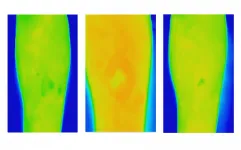(Press-News.org) Researchers at the National Institute of Standards and Technology (NIST) have upgraded their laser frequency-comb instrument to simultaneously measure three airborne greenhouse gases -- nitrous oxide, carbon dioxide and water vapor -- plus the major air pollutants ozone and carbon monoxide.
Combined with an earlier version of the system that measures methane, NIST's dual comb technology can now sense all four primary greenhouse gases, which could help in understanding and monitoring emissions of these heat-trapping gases implicated in climate change. The newest comb system can also help assess urban air quality.
These NIST instruments identify gas signatures by precisely measuring the amounts of light absorbed at each color in the broad laser spectrum as specially prepared beams trace a path through the air. Current applications include detecting leaks from oil and gas installations as well as measuring emissions from livestock. The comb systems can measure a larger number of gases than conventional sensors that sample air at specific locations can. The combs also offer greater precision and longer range than similar techniques using other sources of light.
NIST's latest advance, described in a new paper, shifts the spectrum of light analyzed from the near-infrared into the mid-infrared, enabling the identification of more and different gases. The older, near-infrared comb systems can identify carbon dioxide and methane but not nitrous oxide, ozone or carbon monoxide.
Researchers demonstrated the new system over round-trip paths with lengths of 600 meters and 2 kilometers. The light from two frequency combs was combined in optical fiber and transmitted from a telescope located at the top of a NIST building in Boulder, Colorado. One beam was sent to a reflector located on a balcony of another building, and a second beam to a reflector on a hill. The comb light bounced off the reflector and returned to the original location for analysis to identify the gases in the air.
A frequency comb is a very precise "ruler" for measuring exact colors of light. Each comb "tooth" identifies a different color. To reach the mid-infrared part of the spectrum, the key component is a specially engineered crystal material, known as periodically poled lithium niobate, that converts light between two colors. The system in this experiment split the near-infrared light from one comb into two branches, used special fiber and amplifiers to broaden and shift the spectrum of each branch differently and to boost power, then recombined the branches in the crystal. This produced mid-infrared light at a lower frequency (longer wavelength) that was the difference between the original colors in the two branches.
The system was precise enough to capture variations in atmospheric levels of all of the measured gases and agreed with results from a conventional point sensor for carbon monoxide and nitrous oxide. A major advantage in detecting multiple gases at once is the ability to measure correlations between them. For example, measured ratios of carbon dioxide to nitrous oxide agreed with other studies of emissions from traffic. In addition, the ratio of excess carbon monoxide versus carbon dioxide agreed with similar urban studies but was only about one-third the levels predicted by the U.S. National Emissions Inventory (NEI). These levels provide a measure of how efficiently fuel combusts in emissions sources such as cars.
The NIST measurements, in echoing other studies suggesting there is less carbon monoxide in the air than the NEI predicts, put the first hard numbers on the reference levels or "inventories" of pollutants in the Boulder-Denver area.
"The comparison with the NEI shows how hard it is to create inventories, especially that cover large areas, and that it is critical to have data to feed back to the inventories," lead author Kevin Cossel said. "This isn't something that will directly impact most people on a day-to-day basis -- the inventory is just trying to replicate what is actually happening. However, for understanding and predicting air quality and pollution impacts, modelers do rely on the inventories, so it is critical that the inventories be correct."
Researchers plan to further improve the new comb instrument. They plan to extend the reach to longer distances, as already demonstrated for the near-infrared system. They also plan to boost detection sensitivity by increasing the light power and other tweaks, to enable detection of additional gases. Finally, they are working on making the system more compact and robust. These advances may help improve understanding of air quality, specifically the interplay of factors influencing ozone formation.
INFORMATION:
The work was funded by the Defense Advanced Research Projects Agency and the NIST Special Programs Office.
Paper: F.R. Giorgetta, J. Peischl, D.I. Herman, G. Ycas, I. Coddington, N.R. Newbury and K.C. Cossel. Open-path Dual-comb Spectroscopy for Multispecies Trace Gas Detection in the 4.5 μm to 5 μm Spectral Region. Laser and Photonics Review. Published June 30, 2021. DOI: 10.1002/lpor.202000583
A McGill-led study has shown that the size of the Maya population in the lowland city of Itzan (in present-day Guatemala) varied over time in response to climate change. The findings, published recently in Quaternary Science Reviews, show that both droughts and very wet periods led to important population declines.
These results are based on using a relatively new technique involving looking at stanols (organic molecules found in human and animal faecal matter) taken from the bottom of a nearby lake. Measurements of stanols were used to estimate changes in population size and to examine how they align with information about climate variability and changes in vegetation drawn from other biological and archaeological sources.
By using the technique, the researchers were able ...
Increasing our understanding of cellular processes requires information about the types of biomolecules involved, their locations, and their interactions. This requires the molecules to be labeled without affecting physiological processes (bioorthogonality). This works when the markers are very quickly and selectively coupled using small molecules and "click chemistry". In the journal Angewandte Chemie, a team of researchers has now introduced a novel type of click reaction that is also suitable for living cells and organisms.
As an example, labeling biomolecules allows for the localization and characterization of tumors ...
A new Finnish study shows that 180 health care workers who had received two doses of the Pfizer and Biontech vaccine have very good antibody responses against the SARS-CoV-2 virus. The immune response was as strong against the alpha variant (formerly the UK variant) but was somewhat decreased against the beta variant (formerly the South Africa variant).
Finnish researchers from the University of Turku and University of Helsinki together with Turku University Hospital, Helsinki University Hospital, and the Finnish Institute for Health and Welfare studied the immune response induced by the coronavirus vaccinations, which started in Finland in December. The researchers analysed vaccine responses ...
Growing in popularity, unagi kabayaki - grilled freshwater eel in soy sauce - can be found on the menu of many Japanese restaurants, and is stocked by Asian shops and in specialist supermarkets. But new research tracing the DNA of eel fillets used for this dish has found that fraudulent food labelling is rife, with a third of the products violating EU regulations on the provision of food information. With certain species of eels now endangered, the researchers say that accurate labelling on these products is vital if the global eel trade is to be sustainable.
The European eel is a critically ...
Plants play an essential role in curbing climate change, absorbing about one-third of the carbon dioxide emitted from human activities and storing it in soil so it doesn't become a heat-trapping gas. Extreme weather affects this ecosystem service, but when it comes to understanding carbon uptake, floods are studied far less than droughts - and they may be just as important, according to new research.
In a global analysis of vegetation over more than three decades, Stanford University researchers found that photosynthesis - the process by which plants take up carbon dioxide from the atmosphere - was primarily influenced by floods and heavy rainfall nearly as often as droughts in many locations. The paper, published in Environmental Research Letters on June ...
A key component of next-generation solar panels can be created without expensive, high-temperature fabrication methods, demonstrating a pathway to large scale, low-cost manufacturing for commercial applications.
Nickel oxide (NiO) is used as an inexpensive hole-transport layer in perovskite solar cells because of its favourable optical properties and long-term stability.
Making high-quality NiO films for solar cells usually requires an energy intensive and high-temperature treatment process called thermal annealing, which is not only costly, but also incompatible with plastic substrates, until now precluding the use of ...
Spatial reasoning ability in small children reflects how well they will perform in mathematics later. Researchers from the University of Basel recently came to this conclusion, making the case for better cultivation of spatial reasoning.
Good math skills open career doors in the natural sciences as well as technical and engineering fields. However, a nationwide study on basic skills conducted in Switzerland in 2019 found that schoolchildren achieved only modest results in mathematics. But it seems possible to begin promoting math skills from a young ...
New research shows thermal imaging techniques can predict whether a wound needs extra management, offering an early alert system to improve chronic wound care.
It is estimated that 1-2% of the population will experience a chronic wound during their lifetime in developed countries - in the US, chronic wounds affect about 6.5 million patients with more than US$25 billion each year spent by the healthcare system on treating related complications.*
The Australian study shows textural analysis of thermal images of venous leg ulcers (VLUs) can detect whether a wound needs extra management as early as week two for clients receiving treatment at home.
The clinical study by RMIT University and Bolton Clarke, published in the Nature journal Scientific Reports, is the first to investigate ...
Decision-makers around the world are increasingly interested in using ecosystem solutions such as mangroves, coral reefs, sand dunes and forests on steep slopes to help buffer the impacts from hazard events and protect populations. But what evidence exists to show the efficacy of nature-based solutions over man-made protective measures to reduce the impacts of the increasing numbers of hazard events humanity faces due to climate change?
An international, multi-disciplinary team of 28 researchers has examined nearly 20 years' worth of peer-reviewed studies on the impacts of ecosystem-based disaster ...
A study analysing the association between a wide variety of prenatal and childhood exposures and neuropsychological development in school-age children has found that organic food intake is associated with better scores on tests of fluid intelligence (ability to solve novel reasoning problems) and working memory (ability of the brain to retain new information while it is needed in the short term). The study, published in Environmental Pollution, was conceived and designed by researchers at the Barcelona Institute for Global Health (ISGlobal)--a centre supported by the "la Caixa" Foundation--and ...



